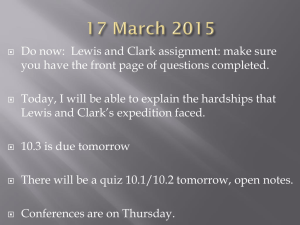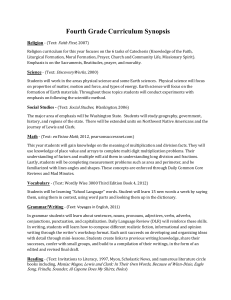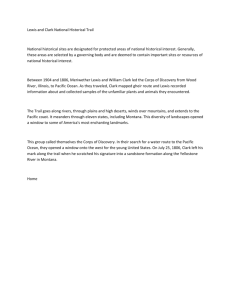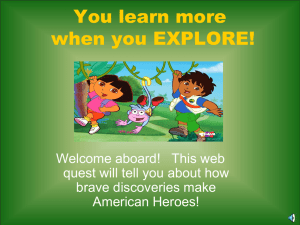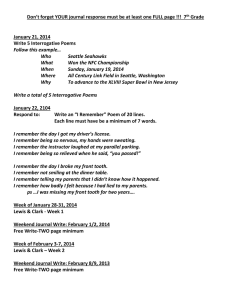Lewis and Clark
advertisement
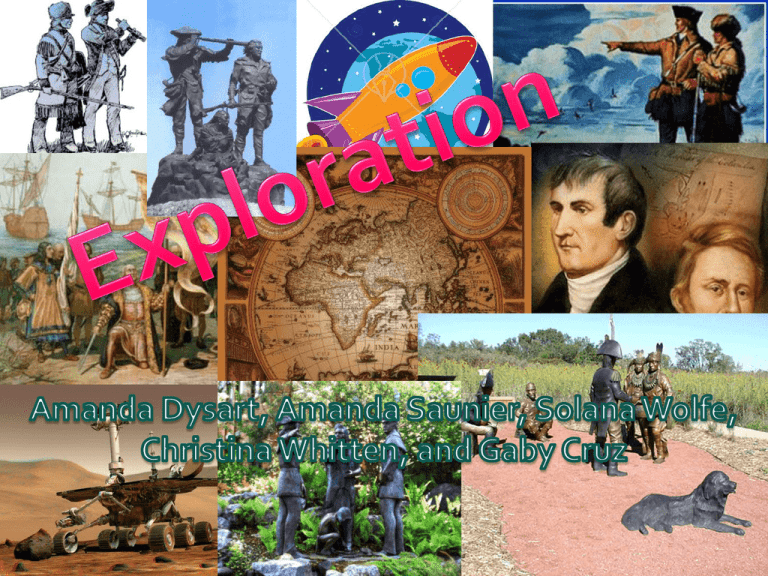
First Grade GPS S1E1. Students will observe, measure, and communicate weather data to see patterns in weather and climate. a. Identify different types of weather and the characteristics of each type. SS1G1 The student will describe the cultural and geographic systems associated with the historical figures in SS1H1a. SS1G3 The student will locate major topographical features of the earth’s surface c. Identify and describe landforms (mountains, deserts, valleys, plains, plateaus, and coasts). SS1H1 The student will read about and describe the life of historical figures in American history. a. Identify the contributions made by these figures: Benjamin Franklin (inventor/author/ statesman),Thomas Jefferson (Declaration of Independence), Meriwether Lewis and William Clark with Sacagawea (exploration), Harriet Tubman (Underground Railroad), Theodore Roosevelt (National Parks and the environment), George Washington Carver (science). b. Describe how everyday life of these historical figures is similar to and different from everyday life in the present (food, clothing, homes, transportation, communication, recreation). ELA1R5 The student acquires and uses grade-level words to communicate effectively. The student a. Reads and listens to a variety of texts and uses new words in oral and written language. b. Recognizes grade-level words with multiple meanings. c. Identifies words that are opposites (antonyms) or have similar meanings (synonyms). ELA1R6 The student uses a variety of strategies to understand and gain meaning from grade-level text. The student a. Reads and listens to a variety of texts for information and pleasure. b. Makes predictions using prior knowledge. c. Asks and answers questions about essential narrative elements (e.g., beginning-middle-end, setting, characters, problems, events, resolution) of a read-aloud or independently read text. ELA1W2 The student writes in a variety of genres, including narrative, informational, persuasive and response to literature. c. Adds details to expand a story. d. Begins to use organizational structures ( beginning, middle, end, and sequence of events) and strategies (transition words and time cue words). e. Begins to develop characters and setting through dialogue and descriptive adjectives. Our Process: As a whole group the class will participate in each lesson. Then after they have finished all five lessons the class will be broken into groups of 4 or 5 students. These students will create a map of their journey (to one of the three destinations: The Desert, “Alaska”, and The Beach), three journal entries, and a list of all supplies needed to succeed on their journey. Table of Contents Slide 4~ Movie Maker Project Slide 5~ Major Roles Slide 6~Record Keeper (Solana Wolfe) Slide 32~ Map Maker (Christina Whitten) Slide 49~ Meteorologist ( Amanda Dysart) Slide 64~Historian ( Gaby Cruz) Slide 76~ Data Analyst ( Amanda Saunier) Our roles… Historian Record Keeper Meteorologist Data Analyst Map Maker By completing each role, it brings us one step closer to being prepared for our journey!!! By the end of all lessons we will have completed our map, journal entries, and our list of supplies Solana Wolfe Standards: SS1H1 The student will read about and describe the life of historical figures in American history. a. Identify the contributions made by these figures: Benjamin Franklin (inventor/author/ statesman),Thomas Jefferson (Declaration of Independence), Meriwether Lewis and William Clark with Sacagawea (exploration), Harriet Tubman (Underground Railroad), Theodore Roosevelt (National Parks and the environment), George Washington Carver (science). b. Describe how everyday life of these historical figures is similar to and different from everyday life in the present (food, clothing, homes, transportation, communication, recreation). ELA1R5 The student acquires and uses grade-level words to communicate effectively. The student a. Reads and listens to a variety of texts and uses new words in oral and written language. b. Recognizes grade-level words with multiple meanings. c. Identifies words that are opposites (antonyms) or have similar meanings (synonyms). ELA1R6 The student uses a variety of strategies to understand and gain meaning from grade-level text. The student a. Reads and listens to a variety of texts for information and pleasure. b. Makes predictions using prior knowledge. c. Asks and answers questions about essential narrative elements (e.g., beginning-middle-end, setting, characters, problems, events, resolution) of a read-aloud or independently read text. ELA1W2 The student writes in a variety of genres, including narrative, informational, persuasive and response to literature. c. Adds details to expand a story. d. Begins to use organizational structures ( beginning, middle, end, and sequence of events) and strategies (transition words and time cue words). e. Begins to develop characters and setting through dialogue and descriptive adjectives. Journal Keeping While on their long journey, Meriwether Lewis kept a journal of all the events that occurred during their travels. Because of his journal we have record of their whole journey! This is an actual entry from Lewis’s journal! Journal Keeping: Keeping a journal is something that many people do. They use them to track events that happened or important people, places and things they encountered. How many of you keep a journal at home? What are some things that you write about in your journals? A Newfoundland named Seaman kept Meriwether Lewis company on his great expedition! We will be reading from his journal To learn more about their journey! First GRADE GPS: M1N3. Students will add and subtract numbers less than 100, as well as understand and use the inverse relationship between addition and subtraction. h. Solve and create word problems involving addition and subtraction to 100 without regrouping. Use words, pictures and concrete models to interpret story problems and reflect the combining of sets as addition and taking away or comparing elements of sets as subtraction. This is where Lewis and Seaman began their journey! Meriwether Lewis and Seaman travelled many miles on there journey! Let’s think!!! Lewis and Seaman travelled 40 miles the first day of their journey. On the second day they travelled ten less miles than they did on Monday. Then on the third day they travelled STOP! LET’S 60 more miles! THINK THIS THROUGH! Where should we start? So to answer our problem… We know that on the first day they travelled 40 miles, but the second day 10 less…So how can we put this into a problem to figure out how many miles were travelled on the first two days? 4 0 -1 0 3 0 Now that we know how many miles were traveled on the 4 0 second day… What do we need to do next?! ADD all three days together!!! 3 0 +6 0 ? ? Let’s look at it like this! 40+30=? 70 Now lets add 70+60=? Start here! Now count! We find that 7+6= 13! So now we can put back in our zeros! And we find that 70+60=130! Now to figure out… Now that we figured out how many miles they traveled in all three days we need to know how many miles they traveled on the first and third day! Now remember! They travelled 40 miles on the first day and 60 miles on the third day! So think! What operation do we need to use! We can answer this question in two different ways! What are the two ways we can use? We can use either addition or subtraction! 130-30= OR 40+60= Which method did you choose? Why? Now what was our answer? 100 miles Now that we know more about the distances the travelled… Let learn a little more about the journey Seaman and Lewis took with Clark and Sacagawea. How they travelled! How they travelled Lewis and Clark travelled by many means . This chart gives us an idea about how often they used each means of transportation. 80 60 40 20 0 By Foor By Horse Boat Boat By Foot By Horse And now to our story! Before reading about our wonderful explorers Lewis and Seaman, we need to know some key terms to better understand! Vocabulary: In order to better understand our story there are a few key terms we need to know. These terms are: Newfoundland Adventure Keelboat Route Hauled Legend Keelboats A keel boat is a small water craft that Lewis and Clark used to cross the Mississippi to get to the new Louisiana land. Newfoundland A Newfoundland is a large dog breed. Seaman, our story teller, was a Newfoundland. Adventure: a wild and exciting undertaking Lewis and Clark undertook a great adventure by going beyond the Mississippi River to explore the new territory! Route: an established line of travel Lewis and Clark had to create a map of the route the took on their journey! Hauled: To drag or transport This man is hauling wood. Legend: caption: brief description accompanying an illustration You will find this kind of legend on a map! After finishing our story After we are finished reading, we will grab a sheet of journal paper and write a brief and descriptive journal entry pretending that you are Lewis and Clark describing on day on your journey Then after finishing your entry you will draw a picture to illustrate your journal entry. Grading rubric 4 points 3 points 2 points 1 point Sentences 3-5 complete sentences. Use of adjectives to describe event. 1 punctuation error or less 3 complete sentences. 2 punctuation errors. 2 complete sentences. 3-4 punctuation errors. 1 or less complete sentences. 4 or more punctuation errors. Drawing Very colorful. Illustrates sentences. Easy to see what drawing Illustrates sentences. Lack of color. Pencil only illustration. Does not illustrate sentences References Google images http://www.google.com United streaming Seaman’s Journal: On the Trail with Lewis and Clark by Patricia Reeder Eubank Click on “Look” to watch a video! SS1G1 The student will describe the cultural and geographic systems associated with the historical figures in SS1H1a. SS1G3 The student will locate major topographical features of the earth’s surface c. Identify and describe landforms (mountains, deserts, valleys, plains, plateaus, and coasts). What do you need on a trip? •Food •Clothing •Tools •Camping gear •transportation What did Lewis and Clark take on their journey? Clothing and Food •Clothing for all Types of weather •Enough food for everyone •Items to trade for food Transportation •Canoes and boats •Horses The navigating tools they really used!! Equipment and Tools •Tools for building •Equipment for camping and navigating •Weapons for hunting Their budget was $2,500 $696 was spent on presents for the Indians President Jefferson told them to befriend any tribes they met along the way. Budget for Journey Indian Presents 28% Other Materials 72% 2000 1800 $1,804 1600 1400 1200 1000 800 $696 600 400 200 0 Indian Presents Other Supplies Let’s see where they went and what they saw on the way! EXPEDITION ROUTE LETS GO SIGHT SEEING WHAT DO YOU SEE? THEIR JOURNEY Eastern Woodlands Great Plains Rocky Mountains Pacific Northwest GUESSING GAME Which place do each of the pictures belong? Eastern Woodlands, Great Plains, Rocky Mountains, or Pacific Northwest? WOW! Lewis and Clark saw some amazing places! EASTERN WOODLANDS Lewis, Clark, and their men took shelter under the trees. GREAT PLAINS Buffaloes, deer, elk, and antelope are some of the animals they encountered in the Great Plains. ROCKY MOUNTAINS Grizzly bears, moose, and more OH MY!! Can you imagine how Lewis and Clark felt when they saw a grizzly bear?! PACIFIC NORTHWEST Fishing is a big source of food in this area. Lewis and Clark traded with tribes here, and they fished with them! MAP ACTIVITY I’ve seen what Lewis and Clark saw on their journey. I want to see your journey from home to school! Make a map Start at your home Example: Trees, lake, mountain, river Finish at school Locations on map Draw the nature you see on the way Include places you see on the way Example: store, library, hospital Does it make sense? Could a friend look at your map and find their way? Did you leave off important details? RUBRIC Area 3 points 2 points 1 point 0 points Logical Route Route starts at home and finishes at school, clear path between places, a person could look at map and find their way Route starts at home and finishes at school, the path between places is not clear, person looking at map can see where to start and finish but not find their way Only a start and finish, no path No start, no finish, no path Nature Map includes nature they see on the way, at least 3 drawings (lake, river, creek, fields, mountains, trees, etc) Map includes nature they see on the way, only 2 drawings (lake, river, creek, fields, mountains, trees, etc.) Map includes nature they see on the way, only 1 drawing (lake, river, creek, fields, mountains, trees, etc.) Map has no drawings of nature Places Map includes at least 3 places they see on the way ( stores, landmarks, library, hospital, restaurants, schools, museums, etc.) Map includes only 2 places they see on the way (stores, landmarks, library, hospital, restaurants, schools, museums, etc.) Map includes only 1 place they see on the way (stores, landmarks, library, hospital, restaurants, schools, museums, etc.) Map includes only 1 place they see on the way (stores, landmarks, library, hospital, restaurants, schools, museums, etc.) Google Images Discovery Education United Streaming First Grade GPS S1E1. Students will observe, measure, and communicate weather data to see patterns in weather and climate. a. Identify different types of weather and the characteristics of each type. Hi my name is Sam Sparks. I’m a meteorologist. Meteorologists are people who study weather. My job is to understand the conditions that influence weather and then predict the weather. Today’s weather for Georgia will be sunny… With a 30% chance of rain On television you see meteorologists forecasting the weather. They use a map of the United States to show us the different kinds of weather that can be found all over the country. An important job for a meteorologist is to help people know what kind of weather to expect. When we know about the weather we can decide what kind of clothing to wear, how to prepare the garden in case of a freeze or hail storm, be prepared for activities outside, or make the choice to stay indoors to be safe. What is Weather? • Weather is what the air outside is like. Look outside what is the weather like? The temperature tells how hot or cold the weather is. Let’s do a fun activity. Let’s compare the weather! Make a chart about the weather on your own sheet of paper. Observe and compare the weather in the morning and in the afternoon. Tell about the changes. Today’s Weather How It… Looks Sounds Feels Smells Morning Afternoon Hot Weather Charecteristics Cold Wet Hot Weather High Temperature You get Sweaty Really Sunny or Sunny with white clouds You feel the sun on your skin – sometimes you get sunburned and sometimes you get a tan. Clothing and other items to wear during hot weather: Shorts, T-Shirts, Bathing Suits, Sunscreen, Sunglasses, Hats, Tank Tops Cold Weather Low to Freezing Temperatures You shiver or get Goosebumps You can see your breath Possible Snow and Ice Clothing you wear on cold days. Pants, Sweaters/Long Sleeves, Jackets, Snow Caps, Scarves, Mittens, Ear Muffs, Boots Wet Weather Dark Rain Clouds Sometimes Lightning and Thunder Puddles Form Can’t go outside Clothing and other items you need for wet weather. Rain cap, umbrella, rain boots, rain coat Let’s make a bar graph of the class’s favorite type of weather. After we are done making the bar graph, we will answer the following questions: 1) Which weather type was the most favorite? 2) Which weather type was the least favorite? 3) How many people chose hot weather? Cold weather? Rainy weather? 4) How many people are in our class? How did you figure that out from looking at the bar graph? Graph It! Our Favorite Type of Weather 10 9 Number of Kids 8 7 6 5 4 3 2 1 0 Wet Cold Types of Weather Hot Hey Kids, I’m back! So I heard you have been studying Lewis, Clark, and Sacagawea. Well boys and girls I have a treat for you. We will watch a mini video about Lewis and Clark crossing a mountain. I need you to think about the following questions while watching the video. Click The picture of us to play the movie! What type of weather is in the movie? What kind of clothing are they wearing? Would you suggest another type of clothing for them to wear or add to their outfit? Map of Lewis and Clark’s Journey Dressing for the Weather • Lewis, Clark, and Sacagawea need your help! They are going to places that have different weather. Can you help dress them properly? Now it’s YOUR turn! • You will write a postcard to a friend pretending to be Lewis, Clark, or Sacagawea discussing the weather conditions you have come across on your journey. The background of the postcard will be your choice of the types of weather we learned about in class – Hot, Cold, or Wet. You will then create a paper doll of your character and dress them accordingly to the weather you have chosen. Fun Weather Activities and Websites Resources • http://www.dmns.org/NR/rdonlyres/3B87D8E8-5972-485B-A5A6E147245487E1/588/BeaMeteorologist.pdf • http://streaming.discoveryeducation.com/ • www.googleimages.com • http://flash.sonypictures.com/shared/movies/cloudywithachanceofme atballs/site/downloads/wallpapers/cloudy_newsroom_wallpaper_1024 .jpg • http://filmreviewonline.com/wp-content/gallery/cloudy-with-achance-of-meatballs/pk-26.jpg • http://csos.movieset.com/download/movieset/s/jcweou/images/kj5j2t560x420.jpg • http://www.fossweb.com/modulesK2/AirandWeather/activities/whatstheweather.html • http://www.weatherwizkids.com • http://www.theweatherchannelkids.com Theme: Exploration Grade Level: 1st Grade Georgia Performance Standards: 1. SS1H1- The student will read about and describe the life of historical figures in American history. A. Identify the contributions made by these figures: Benjamin Franklin (inventor/author/ statesman), Thomas Jefferson (Declaration of Independence), Meriwether Lewis and William Clark with Sacagawea (exploration), Harriet Tubman (Underground Railroad), Theodore Roosevelt (National Parks and the environment), George Washington Carver (science). 2. SS1CG1- The student will describe how the historical figures in SS1H1a display positive character traits of fairness, respect for others, respect for the environment, conservation, courage, equality, tolerance, perseverance, and commitment. Goal: The students will be able to describe the life and positive character traits of Meriwether Lewis, William Clark, and Sacagawea. Essential Question: What are positive character traits? Hello everyone! My name is Nestor the Worm. Today I wanted to talk about some very important historical American people. These people include Meriwether Lewis, William Clark, and Sacagawea. Not only did these people’s actions affect history, but they displayed positive character traits. What are positive character traits? A unique feature displayed by all the people in a group Positive Character Traits Respect- To think about and have feelings for other people. Treating others as you would want to be treated. Courage- Taking risks to do something important. Fairness- Working well with others. Recognizing that everyone is special and important. The United States buys the Louisiana Territory in the West. 1803 Lewis and Clark meet Sacagawea. Winter 1804-1805 1804 Lewis and Clark begin their journey on May 14. 1806 The journey ends and the explorers return home on September 23. 1. 2. 3. 4. In Georgia, Lewis learned to live where? In the wilderness or the forest At the age of twenty, Lewis joined what? Army President Thomas Jefferson asked Lewis to do what? Explore new bought land in the West What was Lewis in charge of during the journey? Keeping a journal, taking soil samples, collecting plants, and choosing people for the journey 1. 2. 3. How did Clark know Lewis? They were friends in the army Clark also learned how to live where? In the wilderness or the forest What was Clark in charge of during the journey? Keeping a journal, estimating distances, reading the compass, leading the boats, and choosing people for the journey 1. 2. 3. During the journey Lewis and Clark met Sacagawea who was? Shoshone Indian When Lewis and Clark met Sacagawea was married and had a what? Baby What was Sacagawea in charge of during the journey? Interpreting and guiding the explorers How did the explorer’s demonstrate positive character traits? 1. 2. 3. 4. How did they show courage? By fighting a grizzly bear How did they show respect? Treating each other nicely How did they show fairness? By working together To complete the journey, are all of the positive character traits important? Yes 5. Create a pie chart and bar chart showing how important they are. Fairness Courage Respect 0 10 20 30 Respect Courage Fairness How do you show positive character traits at home and school? Home and School Positive Character Traits Chart Home School treating your parents and siblings nicely treating your friends and teacher nicely paying attention paying attention cleaning after yourself working well with others helping your parents sharing and taking turns saying please and thank you saying please and thank you doing your homework completing your homework 1. 2. 3. 4. Choose any explorer you want: Meriwether Lewis, William Clark, or Sacagawea. Write 1 sentence describing their personal life. Write 1 sentence describing one of their positive character traits. Draw a picture of your explorer. Willow, V. (2006). American Heroes: Lewis and Clark with Sacagawea. Boston: Houghton Mifflin. Lewis and Clark’s Historic Trail. Retrieved September 5, 2009, from http://www.lewisclark.net/ Adler, D. A. (2003). A Picture Book of Lewis and Clark. New York: Holiday House. Discovery Education. (2005). The Lewis and Clark Expedition. (didn’t know creator’s name) Character Education Network: Character Traits. Retrieved October 7, 2009, from http://charactered.net/main/traits.asp Wikipedia: Lewis and Clark Expedition. Retrieved September 5 , 2009, from http://en.wikipedia.org/wiki/Lewis_and_Clark_Expedition Images. Retrieved October 6, 2009, from http://images.google.com/imghp?hl=en&tab=wi Data Analyst By: Amanda Saunier Table of Contents • • • • • GPS Video about graphing Dana the Data Analyst Overview Safari Adventure – Tally Chart • • • • • • What is a picture graph? Make your own picture graph What is a bar graph? Make your own bar graph Steps to creating a graph Favorite Ice Cream Graph • GPS: M1D1 Students will create simple tables and graphs, and interpret them. a. Interpret tally marks, picture graphs, and bar graphs. b. Pose questions, collect, sort, organize and record data using objects, pictures, tally marks, picture graphs, and bar graphs. • Goal: After learning about picture graphs and bar graphs, students will be able to create their own picture graph and bar graph using data given to them. Click inside the tv to see a video! I can’t wait to tell you about my job! DANA Hi, I’m Dana, the Data Analyst. My job is to collect information and decide what’s important. I often put my findings into graph form. In this activity, we will be putting our information into bar graphs and picture graphs. Overview… • On Lewis and Clark’s expedition across the United States, they encountered many animals. • Let’s take our own pretend journey and see what animals we can spot. We’re Going on a Safari!! Look!! There’s 3 zebras drinking from the pond… A momma giraffe feeding her two babies… 2 lions resting in the grass… 1 elephant grazing in the grass… And 4 baby monkeys… Let’s Make a Tally Chart for What We Saw… Animals at the Safari: Zebras Giraffes Lions Elephants Monkeys What is a Picture Graph? Easily compare information using pictures. Also known as a Pictograph. Picture Graphs have: 1. A title 2. Pictures or symbols 3. Labels 4. A key 1 student • Now we’re going to make a picture graph with what we found. Questions: Animals That We Saw on Our Safari Zebras Giraffes Lions Elephants Monkeys How many zebras did we see on our safari? Answer: 3 How many elephants did we see on our journey? Answer: 1 Which animal did we see the most of? Answer: Monkeys Which animal did we see the least of? Answer: Elephants What is a Bar Graph? Bar graphs have 4 parts: 1. Title 2. Labels There are always two labels on a bar graph! 3. Bars 4. Scale •Let’s try it with a bar graph… Animals We Saw on Our Safari 5 4 Which animal did we see the most of? Answer: Monkey 3 2 1 0 Questions: z e b r a s g i r a f f e s l i o n s e l e p h a n t s m o n k e y s Which animal did we see the least of? Answer: Elephant Now You Try… Steps to creating a bar graph: 1. Tally Chart 2. Draw bars on graph 3. Color bars. Steps to creating a picture graph: 1. Tally Chart 2. Draw and color your symbols on the graph YOUR TURN! What is your favorite ice cream flavor? vanilla? chocolate? moose tracks? strawberry? Make Your Graphs… Using the template provided and the tally chart on the board, make your own bar graph and picture graph showing your class’ favorite ice cream flavor. References • Data Collection and Graphing. Slim Goodbody. (2000). Retrieved October 19, 2009, from Discovery Education: http://streaming.discoveryeducation.com/ • Google Images. (2009). Retrieved October 1, 2009, from Google: www.google.com • Nussbaum, G. (2005-2006). Lewis and Clark Animals. Retrieved from http://www.mrnussbaum.com/lacanimals.htm
